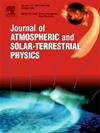Strong thermospheric response to the almost undetectable substorm on May 29, 2023
IF 1.8
4区 地球科学
Q3 GEOCHEMISTRY & GEOPHYSICS
Journal of Atmospheric and Solar-Terrestrial Physics
Pub Date : 2025-01-14
DOI:10.1016/j.jastp.2025.106430
引用次数: 0
Abstract
A ground based FPI (Fabry Perot Interferometer) at the Athabasca Observatory detected an unusual strong and storm-like equatorward meridional wind of up to 450 m/s on May 29, 2023, a geomagnetically quiet day (AE < 150 nT, Kp < 1). F18 DMSP SSUSI, a Far Ultra-Violet (FUV) spectrograph imager, observed a long lasting (∼7 h) auroral substorm on the same day. TIMED/GUVI data showed a O/N2 depletion that extended to mid/low latitudes over a limited longitude range in the northern hemisphere. Concurrent SuperDARN measurements indicated strong plasma convection around the substorm location, suggesting a strong local heating (Joule and particle precipitation heating) near the substorm location. This strong and localized heating caused the storm-like response in the thermospheric meridional wind and composition. Furthermore, the FPI also observed a strong zonal wind (up to 180 m/s), which changed its direction from westward to eastward during the substorm. Such a change is due to the competition between the pressure gradient and Coriolis forces. In the Northern Hemisphere, the Coriolis force is westward with an equatorward meridional wind during the substorm; the direction of the pressure gradient force changed from westward to eastward due to changes in the relative locations of the observatory and the substorm. A strong IMF By and periodic variation in the IMF likely provide a favorable upstream condition for continuous energy input from the solar wind to the magnetosphere and/or the release of the stored magnetospheric energy into the thermosphere to drive the long duration substorm and the observed thermospheric changes.
2023年5月29日,对几乎无法探测的次暴的强烈热层响应
2023年5月29日,地磁平静的一天,阿萨巴斯卡天文台的地面FPI(法布里·珀罗干涉仪)探测到一股不寻常的强劲风暴样的赤道经向风,风速高达450米/秒。150 nT, Kp <;1). F18 DMSP SSUSI,远紫外(FUV)光谱仪成像仪,在同一天观测到一个持续时间很长(~ 7小时)的极光亚暴。TIMED/GUVI数据显示,在北半球有限的经度范围内,O/N2耗竭扩展到中/低纬度地区。同时进行的SuperDARN测量表明,在亚暴位置周围存在强烈的等离子体对流,表明在亚暴位置附近存在强烈的局部加热(焦耳加热和粒子降水加热)。这种强烈的局部加热引起了热层经向风和成分的类似风暴的响应。此外,FPI还观测到强烈的纬向风(高达180米/秒),该风在次暴期间由西风转为东风。这种变化是由于压力梯度和科里奥利力之间的竞争。在北半球,科氏力是向西的,在次暴期间有一个向赤道方向的经向风;由于天文台与亚暴相对位置的改变,气压梯度力的方向由西向东转变。强的IMF By和IMF的周期性变化可能为太阳风持续向磁层输入能量和/或将储存的磁层能量释放到热层,从而驱动持续时间较长的亚暴和观测到的热层变化提供了有利的上游条件。
本文章由计算机程序翻译,如有差异,请以英文原文为准。
求助全文
约1分钟内获得全文
求助全文
来源期刊

Journal of Atmospheric and Solar-Terrestrial Physics
地学-地球化学与地球物理
CiteScore
4.10
自引率
5.30%
发文量
95
审稿时长
6 months
期刊介绍:
The Journal of Atmospheric and Solar-Terrestrial Physics (JASTP) is an international journal concerned with the inter-disciplinary science of the Earth''s atmospheric and space environment, especially the highly varied and highly variable physical phenomena that occur in this natural laboratory and the processes that couple them.
The journal covers the physical processes operating in the troposphere, stratosphere, mesosphere, thermosphere, ionosphere, magnetosphere, the Sun, interplanetary medium, and heliosphere. Phenomena occurring in other "spheres", solar influences on climate, and supporting laboratory measurements are also considered. The journal deals especially with the coupling between the different regions.
Solar flares, coronal mass ejections, and other energetic events on the Sun create interesting and important perturbations in the near-Earth space environment. The physics of such "space weather" is central to the Journal of Atmospheric and Solar-Terrestrial Physics and the journal welcomes papers that lead in the direction of a predictive understanding of the coupled system. Regarding the upper atmosphere, the subjects of aeronomy, geomagnetism and geoelectricity, auroral phenomena, radio wave propagation, and plasma instabilities, are examples within the broad field of solar-terrestrial physics which emphasise the energy exchange between the solar wind, the magnetospheric and ionospheric plasmas, and the neutral gas. In the lower atmosphere, topics covered range from mesoscale to global scale dynamics, to atmospheric electricity, lightning and its effects, and to anthropogenic changes.
 求助内容:
求助内容: 应助结果提醒方式:
应助结果提醒方式:


